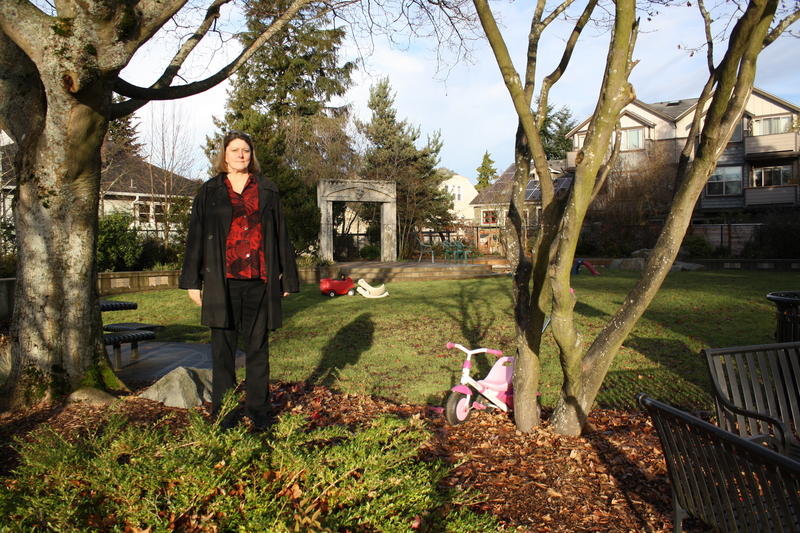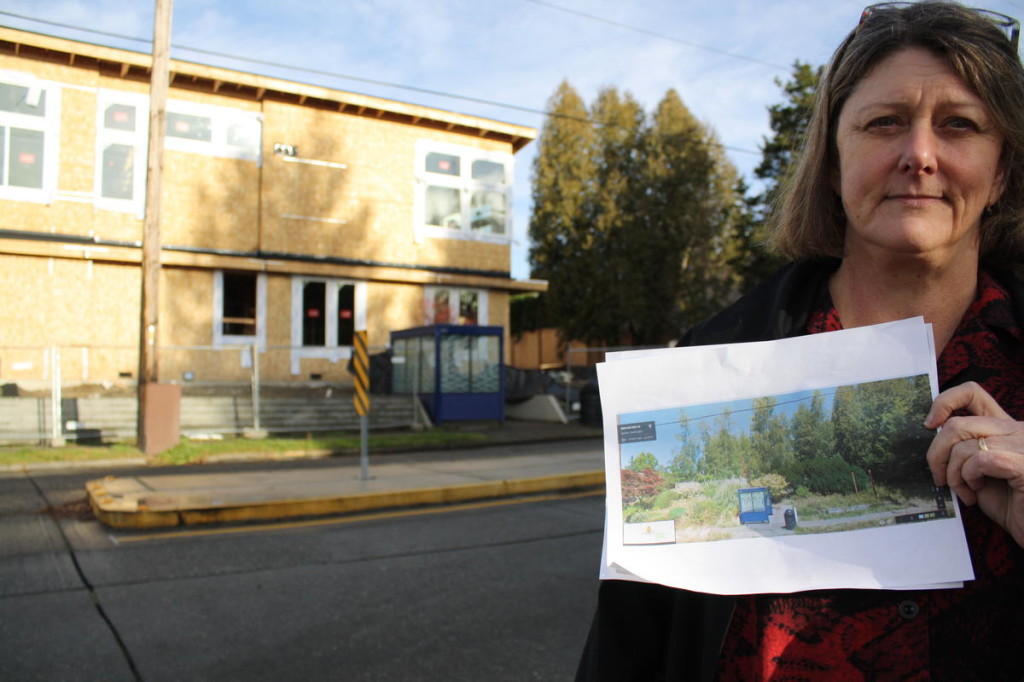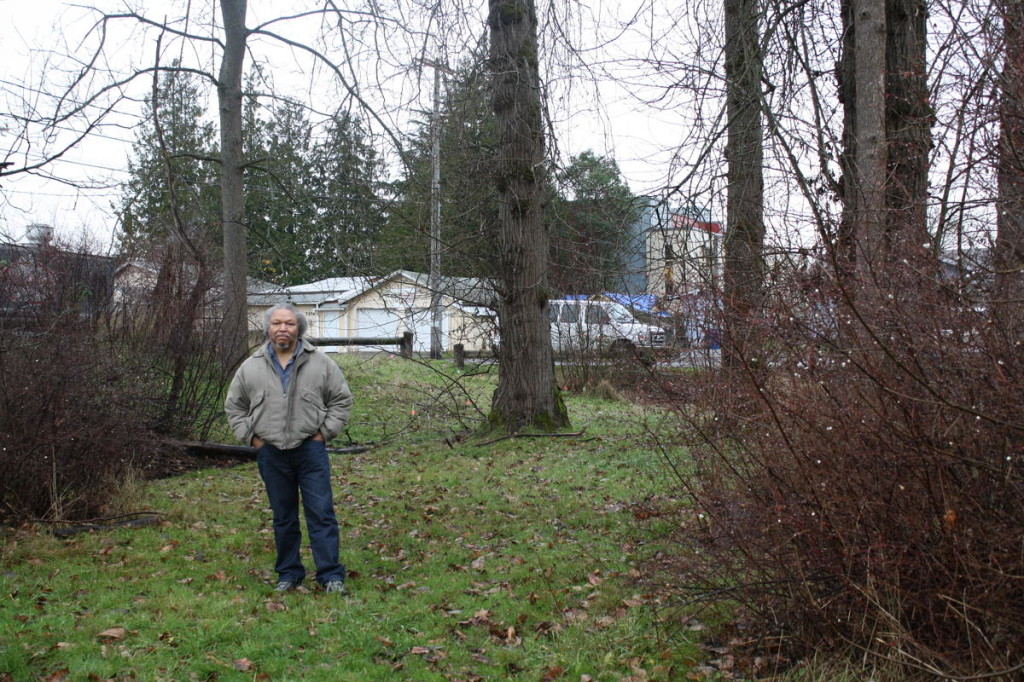
Cass Turnbull, an open space advocate, says the 6th Avenue pocket park in Greenwood shows how a former substation can make a great park.
Seattle City Light is selling off a bunch of obsolete substations. Some open space activists want to nab that land for parks or other open space, but it turns out it’s not so easy to transfer land from one department to another.
You may have seen electrical substations around Seattle. There’s usually a fence with a bunch of weird-looking electrical equipment inside. There’s usually a concrete slab, or gravel. Often they’re surrounded by mature landscaping that helps them blend into the neighborhood. But changing technology has rendered them obsolete.
Open space advocate Cass Turnbull can’t drive by them without thinking of their potential as parks.
“Yeah, I’ve seen them when I’m driving, like, 40 miles an hour. And I’ll go, ‘ERRRRR!'” Turnbull said, imitating the sound of her car braking. “I recognize that fence, there’s a substation in there!”
The substations are being sold off in batches. Falling energy prices have cut away at revenue Seattle City Light used to make selling excess hydropower on the wholesale market.
Most of northeast Seattle’s substations have been sold. Southwest Seattle’s substations are being cleaned and cleared and should hit the market next year. Substations in northwest Seattle will follow in the years after that.
Community groups that want to see the former substations become parks, tree banks or community gardens must compete against developers for the properties.

Cass Turnbull stands before a former substation site. She holds a Google Street View image showing the landscaping recently removed to make way for townhomes.
Turnbull showed me a substation in northeast Seattle that’s being turned into townhomes.
“Well this was another heartbreak because it did have such a nice landscape,” she said, looking at a printout from Google maps that shows the mature landscaping; landscaping now scraped away. “Seattle City Light had a real heritage of great horticulture. Beautiful landscapes, well tended over the years, and I think that’s all going by the wayside now.”
Seattle Parks and Recreation prefers parks to be 10,000 feet or more.
“Smaller parks don’t work very well,” explained spokesperson Joelle Hammerstad. “There are plenty of examples in Seattle and around the country of the challenges and failures of small pocket parks. Larger parks tend to have more utility, more eyes on the park and are generally more successful.”
Turnbull is tired of hearing that reason.
“There’s always a good reason not to save a substation,” she said. “But my position is that we need as much green space as we can get our hands on, because we’re going to have a whole lot more density.”
Turnbull said a determined neighborhood can hold on to these sites. She took me to the 6th Avenue Pocket Park in Greenwood and pointed to the mature trees around the perimeter. “[These] were kept from the original substation. These aren’t little dinky trees that we have to wait 30 years to find.”
The park was paid for using money from the Pro Parks Levy and King County. But Turnbull said the current system requiring full payment for land the city already owns is too onerous.
Turnbull and the West Seattle Greenspaces Coalition asked for all nine of the substations in southwest Seattle, which includes one in Seatac and another in Burien, to become open space. But the group didn’t have the money to buy them and it didn’t have support from the Parks Department.
The green space group’s plan also didn’t fly with Seattle City Light.
“We have a goal in mind, which is to be able to sell these properties to meet our budgetary needs,” said Lynn Best who heads the utility’s real estate department.
Best said utilities don’t have a lot of discretion, either. “Under state law, if you have utility property, it either has to be used for utility purpose, or we have to get full market value for selling it or renting it.”
Still, Best said Seattle City Light does what it can to accommodate community groups. “Sometimes a property comes along that is particularly valuable to a particular community,” she said. “If people have a serious plan for how they want to go about doing this, we will certainly listen and try to help.”

Willard Brown of the Delridge Neighborhoods Development Association wants this former substation to become a community garden. Behind the photographer, a fenced-in area with polluted ground will have to be cleaned up, Brown said.
Willard Brown of the Delridge Neighborhoods Development Association wants this former substation to become a community garden. A fenced-in area on one corner of the site is polluted, and will have to be cleaned up, Brown said.
For example, one proposal caught Best’s attention. It came from Willard Brown, a member of the Delridge Neighborhoods Development Association in southwest Seattle.
Brown said the Delridge neighborhood looks green, as you’re driving through it, but all that green is in inaccessible Green Belts, up on the hillsides.
“You cannot get in there,” he said, “unless you’re willing to be Paul Bunyan and clear a path!”
Brown continued, “Even though we have greenbelts running throughout Delridge, accessible green space for entertainment and pleasure is minimal.”
Brown wants the Delridge substation to become a community garden. “Kids like working in gardens,” Brown, a grandfather, said knowingly.
He considers himself lucky to have a backyard where his grandkids can plant, harvest and compost. “They don’t like mowing lawns,” he said, “but they do like digging in the dirt.”
Brown gestures towards the K-5 STEM at Boren Elementary School just down the road. He said a community garden will give the kids something to do after school besides play video games.
“When we were young, you didn’t have sit-down games and sit around the house and look at TV. In fact, if you’re in front of the TV, you got kicked out of the house!”
Brown said there aren’t many places in Delridge where you can send kids anymore. But for Brown, there’s much more at stake for the kids in this neighborhood than just getting enough exercise. He said when people grow food together in a public place, they become a community.
“We learn culture that way. We learn about each other that way,” he said. And in a diverse neighborhood like Delridge, Brown said creating destinations where the community can meet each other is critical.

Willard Brown
Brown said he wants the kids in his neighborhood to take pride in Delridge, saying he’ll consider the project a success when the kids pass by the neighborhood when they get older and he hears them say, “Hey, there’s my garden. That’s our garden. It’s still here.”
But even with Seattle City Light’s support, paying full market value has proved a burden to Brown’s group. They’re working on grant proposals to come up with the $80,000 to $90,000, but nothing’s come through yet.
And as Seattle City Light prepares to offload southwest Seattle’s unneeded substations, the clock is ticking.
Any sale of the utility’s land must be approved by the Seattle City Council. That process should happen for southwest Seattle’s substations early next year.
